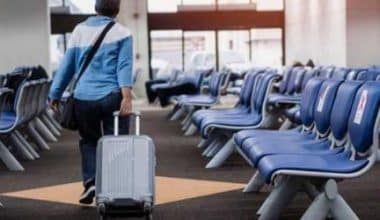If you don’t fly frequently and have an upcoming trip, you may wonder: Can you bring food on a plane? For the most part, yes, you can bring food with you in most cases. Basically, you do not have to buy food at the airport or wait until you arrive at your destination.
However, there are exceptions. So, here’s an overview of the general rules for flying with food.
Can You Bring Food on Planes?
The short answer is that you can bring food on a plane and go through TSA, but… not all food. Experts recommend remembering these two general TSA food rules: A solid item can pass through a checkpoint. However, it must be checked if it is liquid and weighs more than 3.4 ounces.
Things get a little trickier after that. Can you bring food on a plane, such as a sandwich? Yes. How about some cheese? It all depends. PB&J? Yes, for the sandwich, but maybe not for the individual ingredients. Confused? We understand, and we’ll get into more detail below.
Remember that most of these rules only apply when traveling within the United States; international rules may differ. If you’re traveling internationally, you should also check with customs about declaring any foods you bring back from another country. The TSA website has a comprehensive list of food items you can and cannot bring on your upcoming trip. You might be surprised to learn that these unusual items made it through security.
Can You Pack Food in a Checked Bag?
The Transportation Security Administration has several rules, and knowing what is permitted before arriving at the airport can help you prepare better. The following are the most important TSA food rules for checked luggage.
Solid foods
No size restrictions exist on bringing solid food items in your carry-on bag or checked luggage. Of course, bag and weight restrictions apply, and if your item is larger than permitted, you may be charged additional fees.
Foods in liquid and gel form
TSA liquid food rules are generally stricter. The same rules apply to liquid and gel food items as they do to liquid and gel toiletries.
All liquid or gel food items larger than the 3.4-ounce maximum liquid carry-on size must be packed in checked baggage; otherwise, they will not pass through security screening.
Other foods subject to the 3.4-ounce sizing restriction in your carry-on include:
- Creamy Cheeses.
- Canned Food
- Liquid Chocolate
- Hummus and peanut butter
- Honey.
- Ice cream.
- Gravy.
You’d be better off packing or not bringing these items in checked luggage.
What About Taking Baby Food, Breast Milk, or Formula on the Road?
There are different TSA liquid rules in place for baby food and drink. In a carry-on bag, “reasonable quantities” of baby food — even more than 3.4 ounces — are permitted. Formula, breast milk, and juice are all acceptable liquids, and they don’t have to fit in a quart-sized bag like other carry-on liquids.
Prepare to remove these items from your bag and notify TSA personnel so they can be screened. These items will most likely be screened separately from other items.
Even if your child is not traveling with you, you can bring breast milk and formula with you. This is because breast milk and formula are considered medically necessary fluids.
Can You Bring Frozen Food on a Plane?
In certain circumstances, you can bring frozen food on an airplane. For example, if your frozen food is solid, such as meat, seafood, or vegetables, you can bring it on the plane in your carry-on or checked luggage without worrying about container size.
If frozen food or drinks are partially melted or slushy, they must meet the 3.4-ounce liquids sizing requirements to pass through security in carry-on bags.
Can You Bring Food and Beverages Purchased After Passing Through the Security Checkpoint?
After passing through security, the size of liquid food and drink items is no longer an issue, as bringing food and liquids purchased after security is permitted. After security, you can bring coffee, take-away meals, or other snacks on the plane.
All larger liquid or gel items and food purchased after passing through the TSA checkpoint are permitted to be brought on board. It is permissible to purchase a snack or lunch before boarding your flight.
Can You Bring a Sandwich on a Plane?
Because PB&Js are cleared for takeoff, feed the family with homemade sandwiches while you fly! So is ham and cheese, bologna and mustard, a deli hoagie, avocado toast, and other foods. You can bring it through TSA and onto the plane if it fits in your bag and has layers of food between the bread, though your neighbors will probably be grateful if you leave the egg salad and other fragrant options at home. (This is just one example of how you can be courteous when flying.)
Can You Bring Drinks on a Plane?
Any liquids in containers larger than 3.4 ounces are prohibited from being brought through security, so you can’t bring a large drink from home or outside the airport. However, if you can find small bottles of 3.4 ounces or less that fit in your single one-quart bag, you can take them through security. Of course, once you’ve cleared security, you’ll have access to a world of high-priced airport beverages. Everything from a latte to a smoothie, bottled soda, to overpriced water can be brought on board and to your airport seat.
If you don’t want to spend money at the airport, there is a workaround: ice. Water or juice in solid, frozen form is permitted through security because it is not a liquid… yet. So, you can freeze a water bottle or juice box, carry it with you, and then drink it once it has thawed. However, if frozen liquid items are partially melted, slushy, or have any liquid at the bottom of the container, they must meet the 3-1-1 liquid requirements, according to the TSA.
Consider bringing a reusable water bottle instead, chug it before going through security, or arrive with it empty and fill it up after you’ve been cleared. Furthermore, “medically necessary gel ice packs in reasonable quantities” are permitted, regardless of their physical state (melted or slushy). If you’re bringing baby supplies, the same rules apply.
Can You Bring Holiday Food on a Plane?
Whether you’re in charge of bringing the gingerbread house, traveling with edible gifts, or can’t stop eating leftover stuffing, knowing what’s safe to fly is important.
First, the good news: you can bring gingerbread houses, as well as cakes, pies, cookies, and other baked goods. Meats (including the holiday ham), fresh fruits and vegetables, and stuffing are all acceptable. Casseroles are also acceptable (though they may be difficult to transport). However, runny icing, cranberry sauce, eggnog, canned sugar plums, and other canned fruits must be less than 3.4 ounces in weight, or they must be checked.
While you may be your family’s designated Christmas ham carver, remember that sharp objects will not pass through security, so leave them at home. Of course, any holiday treats purchased at the airport and passed through security are permissible to bring on the plane.
Can You Bring Alcohol on a Plane?
The only absolute no for food and drinks you can’t bring on a plane? Alcohol that is more than 140 proof. It will not pass through security in your carry-on or checked bag. Less potent mini-bottles weighing less than 3.4 ounces may be brought through security, but anything larger must be checked.
Alcohol purchased at an airport, such as a duty-free shop, can be brought on the plane, but it must be stored for the duration of the flight and cannot be consumed during the flight. It is illegal to consume the alcohol you bring onto the plane en route, so keep those minis safely stashed in your carry-on.
Can You Bring a Pizza on a Plane?
A Domino’s pickup is cheaper than any of the terminal’s meal options. Fortunately, the TSA approves pizza… but good luck fitting a whole pie into your carry-on. Before going through security, stack the slices in a smaller container. Of course, any pizza purchased at the airport is acceptable for the flight.
What Foods Are Not Permitted on an Airplane?
Certain foods are prohibited on airplanes, including:
- Liquid or gel food items weighing more than 3.4 ounces are not permitted in carry-on luggage. They are permitted if completely frozen and have no size restrictions.
- Alcohol in containers larger than 3.4 ounces is not permitted in carry-on bags.
- Alcohol with a concentration of more than 24% but less than 70% is limited to 1.3 gallons per passenger and must be in unopened retail packaging.
- Alcohol containing more than 70% alcohol is not permitted on any aircraft, including checked baggage.
- Most fresh fruits and vegetables are not permitted in checked or carry-on bags when flying from Hawaii, Puerto Rico, or the United States Virgin Islands to the United States mainland due to the risk of spreading invasive plant pests.
Why Do Plane Meals Taste Different?
When you fly, your taste buds change. This has been scientifically proven. This is because you smell less on the plane, and smell is extremely important for your taste experience. A pinch of salt and pepper never hurts. It’s also a good idea to bring your spicy tea. Furthermore, it is best to avoid eating too much high-fat food. Digestion changes with the air, and eating fat is more difficult for your body to digest.
Conclusion
You now know what food you can take on an airplane the next time you fly. Baby food and frozen foods are exceptions. All liquids in carry-on bags cannot be larger than 3.4 ounces; otherwise, most liquids can travel via checked luggage (except for alcohol restrictions).
Bringing food onto an airplane is permitted if all TSA rules are followed. When traveling with edible liquids or gels, consider exceptions and size limitations.
Related Articles
- Can You Bring Snacks on a Plane: 2023 TSA Rules
- Carry-On Luggage Size American Airlines: All You Should Know
- How to Pack a Carry On: All You Should Know!!!
- Where Can You See the Northern Lights?






